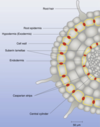Chapter 14 Flashcards
(77 cards)
How do guard cells act around the stomata?
When turgid they swell and open. When flaccid they relax and close.

Where does secondary (lateral) growth come from?
Vascular cambium. Production of secondary xylem on inside and secondary phloem on outside of the vascular cambium ring cells.
What is included in bark?
All tissues external to the vascular cambium, including secondary phloem, cork cambium, and cork.

How does wood form?
As secondary growth continues over the years, layer upon layer of secondary xylem accumulates.
What is lignin?
Coating of xylem that gives wood its hardness and protection.
What are the two zones of secondary xylem?
Heartwood (doesn’t conduct water but is central column that supports tree) and Sapwood (upward transport of water and minerals by xylem sap)

What are the 3 basic kinds of plant organs?
Roots (underground) and stems and leaves (shoots above ground)
What’s the importance of roots and shoots (stems/leaves) systems?
Roots are underground and is where plants get water and nutrients. Shoots are above ground and is where the plant gets CO2 and light energy.
What is apical dominance?
It causes the plant to grow taller at the apical bud instead of wider to increase the plant’s exposure to sunlight.
What are key differences between monocots and eudicots?
1) Monocots have fibrous roots; eudicots have a taproot system 2) Monocots have one cotyledon; Eudicots have two (first leaves that come out of the embryo) 3) Monocots have parallel veins on leaves; Eudicots have netlike veins 4) Monocots have vascular bundles on stems are scattered; Eudicots bundles are in a ring 5) Monocots have one pollen grain opening; Eudicots have three 6) Monocots petal # divisible by 3; Eudicot petal # divisible by 4 or 5
Root hairs are extensions of what?
Individual epidermal cells
What are stolons?
Runners or above ground horizontal stems
What are rhizomes?
Horizontal underground stems
What are tubers?
The ends of rhizomes
Apical meristems
Localized regions of cell division at the tips of shoots and roots that provide for vertical growth.
Stomata
Pores on leaves and organs that allow exchange of carbon dioxide and oxygen. Also major sites for water to leave during evaporation.
Cuticle
Waxed coating on leaves to prevent water loss and act as protection.
Xylem
Vascular tissue from dead cells that flows up to carry water and minerals from high pressure at bottom to low pressure at top during evapotranspiration.
Phloem
Consists of sieve tubes and companion cells that are alive and transport sugar from sugar source to sugar sink.
Why are tracheids, fiber cells, and vessel elements important?
Support and water transport
What are the three basic types of cells in nonmeristematic tissues?
Parenchyma, collenchyma, sclerenchyma
Are parenchyma cells living or dead? Have primary walls or secondary walls?
Living, with thin and flexible primary walls.

What’s the movement of sugars through sieve-tube members by active transport?
Translocation
When the leaf stomata used for gas exchange, including water vapor and that creates a pressure gradient which pulls in more water.
Transpiration
























